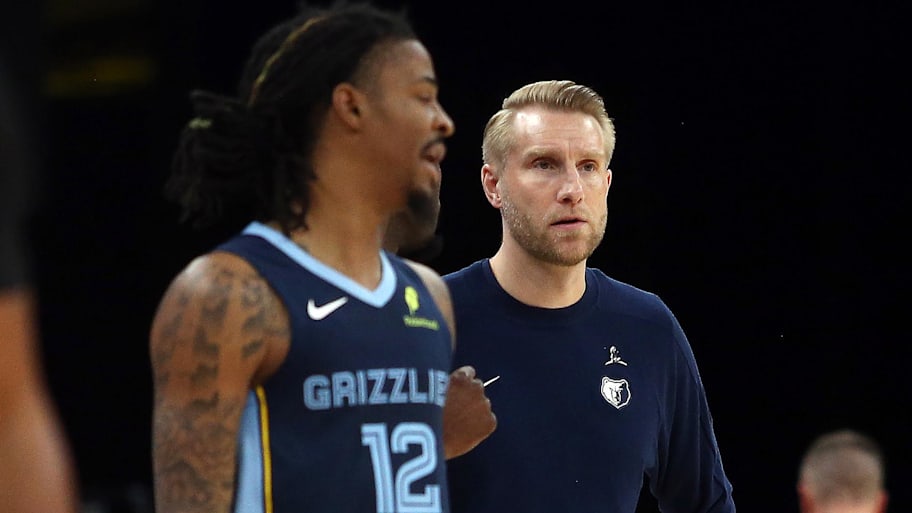Late Monday, following the Grizzlies’ third straight loss, Ja Morant was asked a question: Do you have your usual joy? Morant, fresh off a one-game suspension for a locker room clash with Memphis coach Tuomas Iisalo, who took exception to Morant sleepwalking through last Friday’s loss to the Lakers, was succinct: “No,” Morant said. Could he get it back? Said Morant, “We’ll see.”
Memphis has a problem. The Morant situation is bad, and over the last few days it has gotten worse. Morant’s numbers in the Grizzlies’ loss to the Pistons on Monday were O.K.: 18 points, 10 assists and five rebounds. But in the fourth quarter, Morant scored four points. He attempted two shots. A player once able to take over games has suddenly disengaged in them.
This isn’t some pen-wielding, laptop-tapping reporter’s assessment, either. Blake Griffin criticized Morant’s lack of effort on Amazon Prime Video’s postgame show last week. On his podcast, Draymond Green said after playing against Morant last month he and Stephen Curry felt Morant was engaging in a quiet protest. On his podcast, former Grizzlies guard Danny Green noted that Morant respected former coach Taylor Jenkins, but “I don’t know how much he respects the new guy.”
An NBA scout who crunched the tape on Morant’s last two games offered Sports Illustrated this take on Morant’s play: “He’s not playing hard like he usually does. He’s not getting downhill like he usually does. He’s going slower and stopping and passing out of actions. He just looks checked out.”
For Memphis, this has to be maddening. Throughout Morant’s myriad controversies—which include multiple suspensions for gun possession—the Grizzlies have stuck by him. Last season, with Memphis’s offense stalled, the Grizz fired the head coach (Jenkins) and the assistant (Noah LaRoche) responsible for it. Iisalo was promoted to the head job partly because of his willingness to put the ball back in Morant’s hands in a pick-and-roll heavy system. Morant’s usage rate in the Jenkins/LaRoche–led offense was 30.7%. Closing the season under Iisalo, it jumped to 34.6%.
That honeymoon didn’t last. Morant has had some brilliant games this season. A 35-point outburst in the opener against New Orleans. Another 28—including the game-winner—against the Suns. But Morant’s usage rate is down this season (30.5%, per NBA.com) and his minutes (29.5) are at a career low. His shooting percentages—40.6% from the floor, 15.6% from three-point range—have cratered. Now he is taking pages out of the Jimmy Butler playbook.
Morant has reportedly chafed at Iisalo’s substitution patterns. On Monday, Iisalo deflected specific questions about Morant. But he did defend his quick hooks, telling reporters whatever is lost in frequent substitutions is made up for by having fresher players on the floor. “That is the only goal of the sub pattern,” said Iisalo. “To find a competitive advantage from it.”
Morant, clearly, doesn’t see it that way, leaving the Grizzlies scrambling to figure out (again) if the relationship is salvageable. Iisalo was a complete unknown to most NBA fans when Memphis tapped him for the job. But he is an outstanding coach, earning accolades all across Europe. He’s also a direct coach. In interviews, Iisalo has talked about the need to be brutally honest with players, even stars. “What’s the worst thing that can happen?” Iisalo said on a podcast last year. “Somebody’s going to be upset for a few minutes and we’re going to win more basketball games.” That style worked in Germany, France and Finland. Clearly, Iisalo isn’t interested in modifying it for the NBA.
Across the NBA, rival officials are watching closely. Morant, even with his baggage, is an attractive asset. He’s owed $40-ish million per year over the next three seasons, a big number but not overwhelming for a 26-year-old playmaker with a couple of All-Star appearances on his résumé. The market isn’t what it was in 2022, when Morant finished seventh in the MVP voting. But it exists.
For the Grizzlies, though, any Morant trade is complicated. Morant is the franchise. His connection with the Memphis fan base remains strong. When Morant was introduced in the starting lineup at FedEx Forum on Monday, he was met with loud cheers. The Grizzlies routinely rank in the bottom of the NBA in attendance. They were 26th last season, per ESPN data. The fans who are buying tickets are doing it to watch Morant.
And the Grizzlies, frankly, need to sell those tickets. While expansion is the NBA’s preferred method to get teams in Seattle and Las Vegas, relocation has been discussed, as NBA commissioner Adam Silver told SI last month. And while no league official would come within 100 miles of publicly naming relocation candidates, the Grizzlies and Pelicans—small-market teams with arena deals that expire before the end of the decade—are often whispered as the most likely targets.
In other words, going full rebuild may be out of the question. And the Grizzlies don’t want to do that. They believe the Morant/Jaren Jackson Jr. tandem is the foundation of a contender. They believe a return to health—Memphis, already, has been decimated by injuries—will lead to wins. This isn’t a team looking to sell Morant. It’s one looking to use the assets it has—including the bag of first-round draft picks it acquired from Orlando in the Desmond Bane trade last summer—to add pieces around him.
But they need Morant to be bought in. There are no more coaches to fire or systems to change. Morant is either in on the Grizzlies’ direction. Or he will have to be out.
More NBA on Sports Illustrated
Listen to SI’s NBA podcast, Open Floor, below or on Apple and Spotify. Watch the show on SI’s YouTube channel.
This article was originally published on www.si.com as Inside Ja Morant’s Frustration With the Grizzlies and What It Means for His Future.
